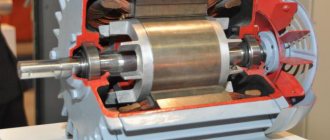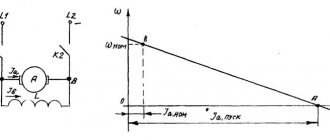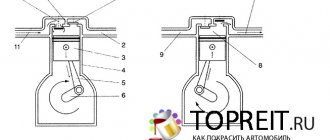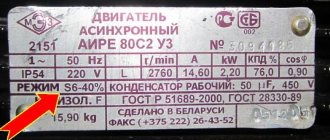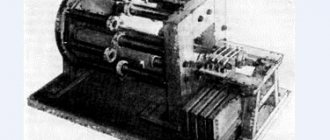There are several ways to check whether the engine is working properly. Devices are used that allow you to see the interturn short circuit; there are devices for detecting breaks (working stands). But the most standard procedure is to check the integrity of the motor windings using a multimeter.
Electric motor
It is impossible to imagine modern life without electricity. Although we use it everywhere, it solves two problems: the problem of lighting and the problem of obtaining mechanical energy from electrical energy.
It was to solve the second problem that electric motors were invented. Electricity in everyday life can have other uses, but such cases are rare.
DC motors have found a place in our lives every day for two centuries. This inevitably led their story to this:
- Today there are a large number of varieties of devices of this type;
- Electric motors have become distinguished by their wear resistance and reliability.
But we all know that no matter how durable and reliable the equipment is, it can fail at any time. To understand the cause of the breakdown, it is very important to diagnose it accurately and scrupulously. The result of the repair and the further service life of the device depend on this. It may even have to be replaced.
No matter how old or new the engine you are dealing with, it consists of two parts:
- stationary (stator);
- rotating part of the structure - the rotor (during the process of rotation it interacts with the stator).
The rotor is also sometimes called an armature. In almost all engines, the armature (rotor) is located inside the stator.
All mechanical work lies on the armature, but whether the rotational movement is rectilinear or not depends on other engine mechanisms. We will not consider them in this article.
Motor rotor and stator
The stator structure contains a stator winding (one or more). When current flows through it, a rotating magnetic field is formed. The generated field interacts with the rotor field, which causes the occurrence of torque. This allows mechanical work to be done. To reduce losses and increase efficiency, the armature is mounted on bearings.
From all of the above, the following conclusion suggests itself about the operation of a serviceable electric motor:
when voltage is applied to the winding, currents flow through it (and the motor design was originally designed for them);
if there is no mechanical damage on the insulation, it serves to ensure the specified resistance;
from a mechanical point of view, the rotor-stator system must comply with all standards (meaning the condition of the bearings, the size of the nuts, clearances, brush wear, etc.).
Checking a DC motor (explicitly or not) includes monitoring these factors. In this case, the check itself can be of any nature: visual inspection, measuring the size of the gaps, monitoring how easily the armature rotates.
Below we will talk only about those elements of the electric motor, the condition of which can only be analyzed using a special device: a multimeter.
When constructing a diagram of all measurements necessary for analysis, it is very important to take into account the design features of a particular engine. It is generally accepted that an electric motor is usually connected to a network with a voltage of 220 or 380 Volts.
It is also worth noting that it is important to pay attention to the reversibility of the engine. This characteristic indicates that at the moment the rotor rotates (when exposed to external influence), an electric current is generated.
Next, we will talk about checking the engine from the point of view of ensuring that it is mechanically fully functional:
- there is no bearing play;
- lubricant is in good condition;
- the gaps between the stator and the armature are within the permitted permissible limits;
- wear of brushes and lamellas of the commutator system is absent or insignificant;
- The power cable is working properly;
- there is no burnt smell.
To ensure the mechanical serviceability of the device, it is sufficient to carry out a routine visual inspection.
If necessary, disassemble the structure carefully. There is no need to add the same mechanical ones to existing faults. During the disassembly process, use only special tools.
During the inspection, you need to pay attention to the following details:
- winding breaks, short circuits on the armature or stator;
- breakdowns in the housing insulation, other metal elements of the motor;
- performance of the capacitor (in a single-phase electric motor).
In general, the scheme for checking the serviceability of the engine does not differ much depending on the type of device, so we will consider it from a single position. If your device has more unique characteristics, it is better to contact an experienced technician.
A DC motor is also called a commutator motor. The serviceability of such an electric motor is checked using a multimeter - a special device.
Multimeter
How to ring the engine? The procedure for ringing with a multimeter is as follows:
- The device must be turned on in a mode that measures resistance (Ohm). Apply the probes in pairs to the lamellas of the collector system. If the electric motor is working properly, the readings will not differ.
- If the engine is working, when the probe is applied to the rotor and commutator at the same time, its resistance is infinitely high.
- Using a multimeter, the presence of a break in the windings is also checked. They should not be present in a running engine.
- Touch the stator with one probe, and the motor terminals with the other. If the indicator value is low, there is a malfunction.
Safety rules during maintenance
Before carrying out maintenance of any complexity, it is necessary to ensure the safety of operating personnel. All maintenance work (except for checking operating conditions) is carried out with complete removal of voltage from the equipment.
The direct executor must ensure that spontaneous or erroneous supply of voltage to the serviced electric motor is blocked. To do this, it is necessary to block the voltage supply, and hang a poster on the lever of the switching mechanism: “Do not turn on, people are working!”
Maintenance of DC electrical machines
Reliable and uninterrupted operation of DC electrical machines can be ensured only with proper operation and systematic care of them. The following are general guidelines for the operation and care of DC electrical machines.
When preparing for start-up, electrical machines are carefully inspected. At the same time, special attention is paid to the cleanliness of the commutator and brushes, as well as the condition of the internal and external contacts. The position of the brushes in the brush holders and the pressing force of the springs are checked. Be sure to check the presence of grease in the bearings and add it if necessary. Then, after checking the position of the adjusting and starting rheostat handles, turn the unit manually 1-2 turns, while checking for jamming and extraneous noise. After making sure that there are no abnormalities or defects, the unit is put into operation.
After starting the unit, monitor its operation using the readings of instrumentation and periodically check the heating of individual parts, the operation of the commutator and brushes.
During normal operation, heating of the machine is caused by the passage of current through the windings and the release of heat, friction in the bearings, friction of the brushes on the commutator and the rotating parts on the air. The manufacturer's instructions usually indicate the permissible heating temperatures of individual parts of the machine. If a larger current flows through the windings (during overloads and short circuits), then the heating of the windings will increase, which can lead to damage to the machine’s insulation.
If there is no or insufficient lubrication in the bearings, the latter quickly heat up and wear out.
Under no circumstances should sparks be allowed between the brushes and the commutator of an electric machine. Sparking can occur if the commutator is dirty or its plates are unevenly worn out, the brushes do not fit tightly or tremble, the amount of current passing through the windings exceeds the calculated value, etc. The most serious attention is paid to the operation of the commutator. Therefore, when the machine is not running, the dirty collector is cleaned with a cloth soaked in gasoline or kerosene. At the same time, if scratches are found on the collector, then it is ground with glass sandpaper. To ensure a tight fit of the brushes to the commutator plates, the brushes are ground with glass sandpaper, which is inserted between the brushes and the commutator. If the brushes are weakly pressed against the commutator plates, then the pressure springs need to be adjusted.
Changing the operating mode of the machine is carried out using appropriate control equipment. After stopping DC electric machines, it is necessary to: inspect the machine outside and inside; remove and wipe dust, dirt and oil from all accessible parts; measure the insulation and feel the contact connections to determine areas of excessive heating; eliminate malfunctions noticed during operation and inspection of the machine.
- DC Generators
- Operating principle, design of DC electrical machines
- Work and current power
- Joule-Lenz law, physical law
- Electric circuit and electrical resistance
Electric motor diagnostics
Diagnostics means measuring certain parameters of the electric motor in operating mode and without voltage.
The following parameters are usually measured:
- Temperature
. This is a universal parameter that can say a lot about the condition of the engine. Operational measurement of the body temperature is carried out using a pyrometer or thermal imager. In some cases, a temperature sensor must be installed in the engine to provide constant temperature control. Read more about temperature conditions and electric motor overheating here. - Current
_ By comparing the rated (operating) current with the measured one, you can assess the condition of the electric motor and the drive as a whole. - Vibration
. When vibration levels increase, mechanical damage to the engine may occur. This parameter is assessed using special equipment.
With the motor de-energized, the insulation resistance is measured using a megohmmeter.
Based on the results of the listed measurements and their comparison with the nominal values, we can conclude that repairs are necessary.
Three phase motor
There are 6 terminals on the body of a three-phase motor, all of them are responsible for the beginning and end of a specific winding. However, they are all the same. This makes the case of breakdown the most difficult.
Working with a multimeter is as follows:
the device in resistance measurement mode determines those pairs of terminals that are responsible for one winding;
The resistance of each is accurately measured and then compared. If there is no difference in the measurements, the windings are working properly and there are no interturn short circuits.
Motor Maintenance
Electric motor maintenance is a planned event for which time must be allocated and a person responsible must be assigned. As a rule, engine maintenance is carried out at the site of its installation, and the following actions are performed:
- cleaning the engine housing from dirt
- checking the mechanical fastenings of the electric motor and the drive as a whole
- checking the integrity and reliability of fastening of the cooling fan impeller (independent fan)
- opening the motor terminal box, inspection, revision and pulling of power terminals
- bearing lubrication
- inspection of the integrity of the power cable and grounding
In addition, when carrying out maintenance, it is necessary to check the engine power system - terminals, contactors, protection devices, etc.
With high-quality regular maintenance of an asynchronous motor, it can operate without repair for decades. However, due to a number of reasons (for example, mismatch of power supply parameters or deterioration of operating conditions), repairs may be required.
The rationale for the need for periodic maintenance of blood pressure is given. An approximate list of works on IM maintenance is proposed. Asynchronous electric motors are distinguished by very high reliability, high uninterrupted operation (subject to the permissible switching time). However, this does not mean that “asynchronous” are eternal. Therefore, it is recommended that each enterprise draw up a maintenance schedule for asynchronous motors. The list of work during maintenance of asynchronous motors may be as follows: 1. External inspection and assessment of the condition of the mechanical part. Maintenance of an asynchronous electric motor should begin with its detailed external inspection. First of all, the presence of obvious faults is determined. The motor housing should be cleaned of dirt and dust using a steel brush. It should not be chipped or damaged. Due to vibrations and dynamic loads, as well as unevenness and defects of the installation site, it often happens that one of the installation “legs” breaks off. Such an engine is rejected and not allowed for further operation. It is imperative to check the presence of the terminal box cover, as well as the cover covering the rotor terminals for motors with a wound rotor. These lids must close tightly, without gaps. Their crushing and damage are not allowed. Each asynchronous electric motor must have a nameplate on its body - a plate with information about the nominal parameters. It is necessary to monitor the readability of all inscriptions on the nameplate and, if necessary, restore them so as not to have “unidentified” electric motors on the farm. When performing maintenance, the engine must be disconnected from the transmission: remove the drive belt, chain or coupling half. After this, you should turn the shaft manually. It should rotate with force due only to the inertia of the rotor; there should be no extraneous sounds, grinding or crunching. The casing that hides the engine impeller (if closed) should be opened. The impeller should not wobble or have any play in any direction; the locking screw should be tightened. The motor shaft should not move in the radial and axial directions, and the sprocket or pulley on the shaft should be securely fastened and not loose. All bolted connections must be tight and threads must not be stripped. Defective parts and fasteners must be replaced. Next, you need to open the bearing caps. The condition of bearings and bearing seats is determined visually. Cracks, chips of bearing rings, and incorrect position relative to the shaft (misalignment) are excluded. Before closing, the bearing assembly is filled with lubricant (oil or special grease). It is generally recommended to check the presence and condition of lubricant in bearing units on a daily basis. 2. External inspection and assessment of the condition of the electrical part To assess the condition of the stator leads and the rotor current collector, the engine covers are opened. The insulation of the stator terminals must be intact, without cracks or damage, otherwise the insulation must be restored using electrical tape and tape. The terminal block, if present, must not be melted or damaged - otherwise it must be replaced. The tips of the stator leads may be oxidized or have carbon deposits on the surface - this is a sign of poor electrical contact. If such defects are present, the tips should be stripped down to metal and the windings should be reconnected according to the required pattern. The cavity of the motor terminal box should be carefully cleaned of dust and dirt. The residual value of the current-collecting rotor brushes of motors with a wound rotor must be at least 4 mm. Their contact surface must be smooth and fit tightly to the slip ring. Chips and cracks on the brushes are excluded. Defective brushes must be replaced. Before installation, they are ground to the surface of the slip ring using glass paper. The slip rings should be cleaned of dust and dirt using a rag soaked in kerosene. Scuffing and damage to slip rings are not allowed. The cause of such defects may be the extreme wear of the brushes that was not noticed in time. Finally, it is necessary to check the condition of the grounding conductor of the electric motor. Its cores must be intact, without damage, and the bolted connections of the tips must be securely tightened. 3. Measurements and tests At this stage, using a megger, the insulation resistance of the stator windings is checked, and for motors with a wound rotor - the rotor windings. The electrical resistance of the stator windings is checked relative to the motor housing, and the resistance of the rotor windings is checked relative to the working shaft. At operating temperature, winding insulation resistance of 0.5 megohms or more is considered normal. In practice, the insulation resistance of serviceable electric motors amounts to tens of megohms. Next, you need to measure the resistance of the stator windings to direct current. The phase-by-phase resistances must be the same, this indirectly indicates the absence of interturn short circuits. For this measurement, it is better to use not a multimeter, but a device with a higher accuracy class, since the resistance of the DC windings is measured in fractions of Ohms. After making the above measurements, the engine is connected to the network, its covers are closed. The engine starts idling. The absence of vibrations and beating of the working shaft is checked, the no-load currents are measured in phases and correlated with each other. The presence/absence of heating of the engine housing is checked by hand for at least 15 minutes of operation. Some temperature rise is normal, and its permissible degree is determined by the insulation resistance class. But, for example, an increase in the housing temperature to 100°C clearly indicates some problems in the operation of the electric motor. Only after this is the engine connected to the transmission of the working mechanism and put into operation under load. Maintenance can be considered completed. 4. General notes The main purpose of maintenance is prevention and timely detection of faults. If the detected defects are not large and serious, a decision is made to eliminate them on site during maintenance. To carry out major and important repairs, engines are delivered to a specially equipped electrical workshop. It is not only asynchronous electric motors that require systematic maintenance. But it is precisely in their relation that this necessity is often neglected. However, the lack of timely maintenance is fraught with serious damage and malfunctions for the engine, the elimination of which can take a lot of time and effort. Mechanical damage to the stator iron may occur, the motor winding may become completely unusable, and even a fire may occur in the box or in the working cavity of the motor. The list of works during maintenance, in agreement with the chief engineer or chief power engineer of the enterprise, does not have to be exactly the same as proposed in this article. Working conditions are of decisive importance: ambient humidity, temperature, dustiness of the room and, finally, work intensity. The same factors should be taken into account when determining the frequency of maintenance of asynchronous motors.
Electric motor repair
In addition to maintenance, if necessary or according to plan, current, medium and major repairs of the electric motor can be carried out. The purpose of repair is to restore the performance or functionality of the engine.
During repairs, based on previously performed inspections and diagnostics, the following activities can be performed:
- bearing replacement
- rotor balancing
- fan impeller replacement
- stator winding rewinding
Other useful materials:
About electric motors with brakes Forced cooling of the electric motor How to choose the right electric motor
Electrical circuits in synchronous motors
The armatures of such motors contain several windings. Their ends, in turn, are connected to metal rings. The rings are installed on the armature shaft, they are accordingly insulated. The rings are mounted on the rotor shaft and have appropriate insulation.
Checking the rotor (provided there is no mechanical damage) is similar to checking the stator. It includes:
- winding resistance measurement;
- checking the presence of an interturn short circuit;
- checking for breakdowns.
Inspection of the electrical component of an asynchronous electric motor.
When inspecting the electrical component, first of all it is necessary to check the condition of the stator terminals. They must be well insulated, and their tips must be clean, without the slightest soot or oxide. Attention should also be paid to the terminal block, which should be intact without any visible damage. Current-collecting rotor brushes must be perfectly smooth, without chips or cracks, and their size must be at least 5 millimeters. They should fit snugly against the slip rings. The slip rings must be free of dust and dirt. At the end, it is recommended to check the condition of the grounding conductor and its fastening.



